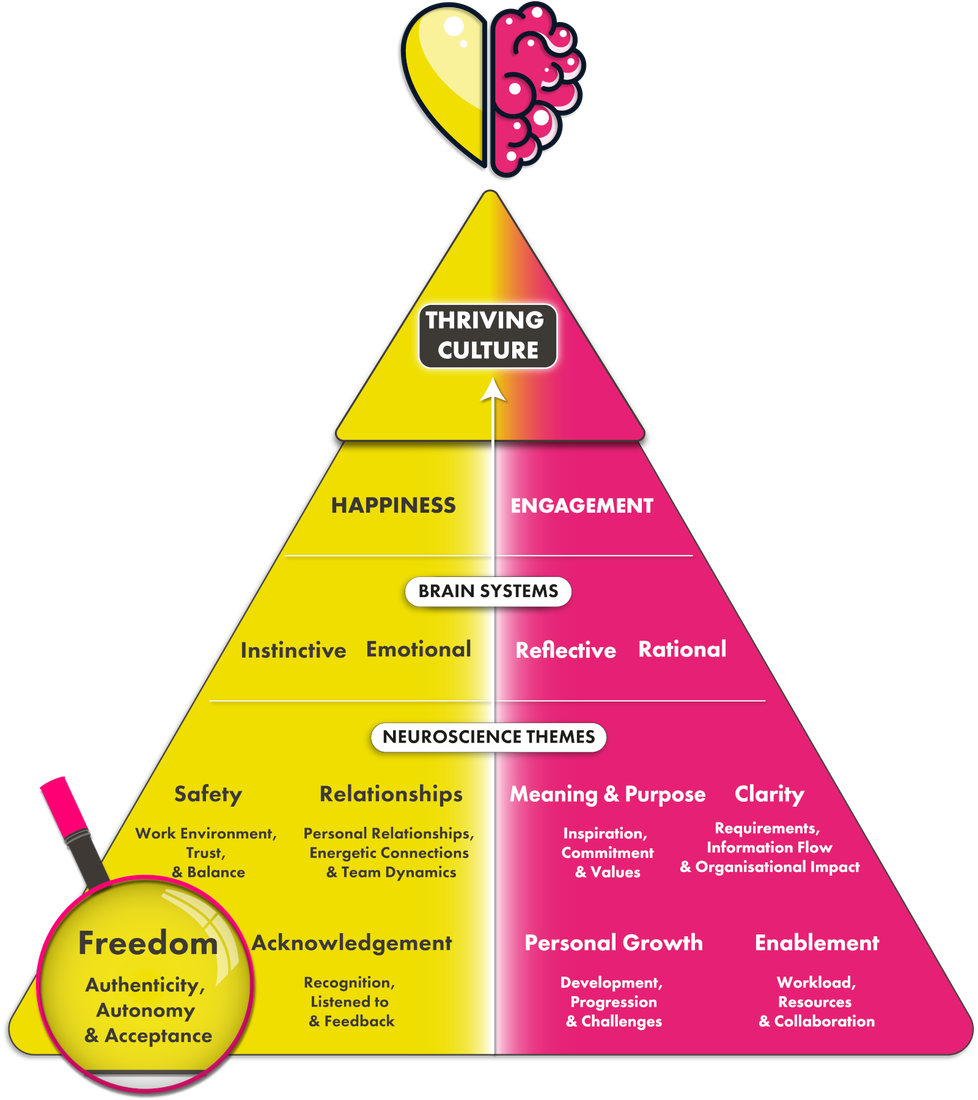Menu


Employee happiness can be linked to authenticity in the workplace. Authenticity is associated with the Instinctive brain system in our neuroscience model.
If you’ve just landed here, we recommend heading over to our brain systems and neuroscience themes pages for an introduction to our neuroscience model and methodology. Otherwise, read on to find out why authenticity is a vital component for workplace happiness.

Freedom means having the ability to act, say and do based on your true beliefs. It’s two sides of the same coin of authenticity. The core of being true to yourself authentically and then being able to express it.
Authenticity sometimes has a bad reputation. People think it means anyone can do whatever they want, as long as they’re expressing their truth, and others just have to accept their behaviour.
However, the root of authenticity comes from being self-aware enough to know it’s not a snapshot; it’s a process, an exploration. Being able to ask those hard questions that we commonly are more comfortable asking others versus internalising for ourselves. This is where authenticity starts, and then comes the external expression of it. Becoming self-aware of your decisions, knowing when you need to navigate things differently, and making a conscious decision to change course when necessary.

When navigating authenticity within the workplace you should acknowledge that there’s no longer any separation between what’s happening as a society and in the workplace today. Not discussing these things is just putting up another mask, another shield, another inauthentic way to show up in life, let alone work.
That’s why purpose and values are so much more important now because these things are non-binary; there is no duality. We are a spectrum of human beings with very different and passionate opinions which reflect our values and what means most to us. It’s not just about work anymore; it’s about the people we want to spend time with, people we love and purposes we are passionate about.
The more we can identify with honesty and authenticity the factors that divide us, the more we can actually acknowledge and identify what unites us. This is the basic need of taking care of the people we love, including ourselves, and ensuring that’s all being recognised and respected. If you can instil purpose, values, and subsequent behaviours, it becomes much simpler and more black-and-white to have respectful discourse. We can agree to disagree, but we still have a common goal at work. So we can begin to separate the logic from the emotion if we’re there for a common purpose for that company, that team, that boss, our colleagues, that makes a very different work environment where you can create wellbeing and happiness.
The former VP of Culture at Starbucks said, at the height of the pandemic, whilst there was a lot of uncertainty, what he loved about focusing on the company’s purpose, and what they were doing for their team was that he didn’t wake up in the morning and go to his phone or turn on the TV. He said he didn’t need to know what was going on in the news because he knew whatever he did that day, he was living up to his purpose. Which is social equity and climate change, so he’s aligned himself with that. He was clear in his own purpose because he identified it and aligned it to what his output was, which directly correlated to the greater impact on the world. He got real with himself, what matters to him, and how he wants to align it in his daily life.
When walking through the journey of your lows in life, start with mindfulness. Sit with the lows and note the difference in what they mean. What did it do to you? What made you feel differently? What did you do differently? It’s a very simple step in noting the difference of whether you’re reacting more emotionally or less emotionally, based on a sense of logic.
In resilience, we can read all these self-help books and inspirational quotes, but what does it really mean? When you’re at the lowest of your lows and can acknowledge the value of understanding the lows, acknowledging that “I got through that low and got to this next high in my life.” Empowering ourselves with the knowledge that “I’ve been through this in a different form before, I didn’t know how I was gonna get out of it before then, but I did.” Therefore you don’t have the answers now, but you know you have it within yourself to get through to the next high.
*This is an excerpt from the Happiness and Humans Podcast with best-selling author, CEO, and Co-founder of Delivering Happiness, Jenn Lim. Click here to listen to the full podcast.
Related articles
Get in touch for a platform tour and a chat with one of our experts to see how we can help you.
Use our ROI calculator to discover how much we can improve your business performance.